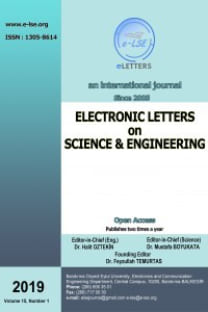Effect of Temperature and Strain Rate on the Embrittlement Behavior of Heat-Treated Carbon Steel (UNS) G10180
Hydrogen embrittlement, temperature and strain rate, Nucleation, mechanical properties, crack propagation
Effect of Temperature and Strain Rate on the Embrittlement Behavior of Heat-Treated Carbon Steel (UNS) G10180
Hydrogen embrittlement, temperature and strain rate, Nucleation, mechanical properties, crack propagation,
___
1. Takahashi, M. (2003) Development of High Strength Steels for Automobiles. NIPPON Steel Technical Report, 88, 1-7.2. Omura, T., Takahashi, T., Souma, A., Amaya, H., Numata, M., Arai, Y., Ohe, T., Ueda, M. (2015) Super-high Strength Low Alloy Steel OCTG with Improved Sour Resistance. NIPPON Steel and Sumitomo Metal Technical Report, 107, 18-23.3. Gavande, S. and Joshi, V. S. (2017) Elimination of Cracks Formation in Stainless Steel after TIG Welding. Proceedings of 88th ISERD International Conference, Dubai, UAE, 1-2 October, 15-19.4. Ren, X., Zhou, Q. J., Shan, G. B. and Qiao, L. (2008) A Nucleation Mechanism of Hydrogen Blister in Metals and Alloys. Metallurgical and Materials Transactions A, 39(1), 87-97.5. Cwiek, J. (2010) Prevention Methods against Hydrogen Degradation of Steel. Journal of Achievements in Materials and Manufacturing Engineering, 43(1), 214-221.6. Gomez, E. V., Amaya-Roncancio, S., Avalle, L. B., Linares, D. H. and Gimenez, M. C. (2017) DFT Study of Adsorption and Diffusion of Atomic Hydrogen on Metal Surfaces. Applied Surface Science, 420, 1-8. 7. Zhang, Z., Obasi, G., Morana, R. and Preuss, M. (2016) Hydrogen Assisted Crack Initiation and Propagation in Nickel-based Superalloy. Acta Materialia, 113, 272-283.8. Nagao, A., Smith, C. D., Dadfarnia, M., Sofronis, P. and Robertson, I. M. (2012) The rolr of Hydrogen in Hydrogen Embrittlement Fracture of Lath Martensitic Steel. Acta Mater, 60, 5182-5189.9. Wang, S., Martin, M. L., Sofronis, P., Ohnuki, S., Hashimoto, N., Robertson, I. M. (2014) Hydrogen-induced Intergranular Failure of Iron. Acta Mater, 69, 275-282.10. Robertson, I. M., Sofronis, P., Nagao, A., Martin, M. L., Wang, S., Gross, D. W. and Nygren, K. E. (2015) Hydrogen Embrittlement Understood. Metal Material Transactions B46, 1085-1103.11. Nagao, A., Martin, M. L., Dadfarnia, M., Sofronis, P. and Robertson, I. M. (2014) The Effect of Nanosized (TiMo)C Precipitates on Hydrogen Embrittlement of Tempered Lath Martensitic Steel, Acta Mater, 74, 244-254.12. Zrnik, J., Mamuzic, I. and Dobatkin, S. V. (2006) Recent Progress in High Strength Low Carbon Steels. METABK, 45(4), 323-331- ISSN: 1305-8614
- Yayın Aralığı: Yılda 2 Sayı
- Başlangıç: 2005
- Yayıncı: Fevzullah TEMURTAŞ
Investigation of Bipolar Disorder with Resting state functional MR
Savunma Sanayi İçin Örnek Bir IoT Uygulaması
Çağatay ERSİN, Mustafa YAZ, Mustafa KARHAN
Geospatial Analysis by Python and R: Geomorphology of the Philippine Trench, Pacific Ocean
Merve KOÇYİĞİT, Ayşegül GÜVEN, Furkan ÇAM
Çevrimiçi Öğrenme Ortamında Akademik Başarıyı Artırmak İçin Karar Destek Sistemi
Hakan KÖR, Hasan ERBAY, Melih ENGİN
